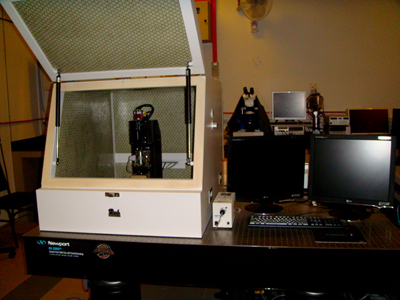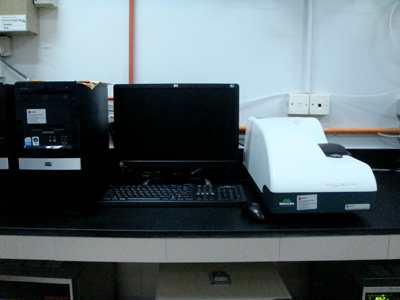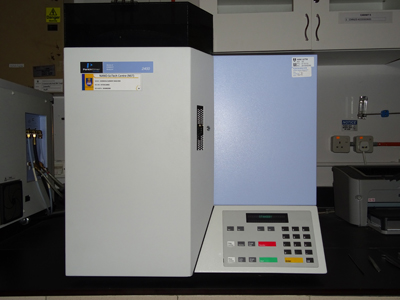
The atomic force microscope (AFM) is one kind of scanning probe microscopes (SPM). SPMs are designed to measure local properties, such as height, friction, magnetism, with a probe. To acquire an image, the SPM raster-scans the probe over a small area of the sample, measuring the local property simultaneously.
| Specifications | ||
| Model | : | XE-100 |
| Brand | : | Park System |
| Optical Magnification | : | 780X (optional 160X, 390X, or 1500X) |
| Field of View | : | 480 µm × 360 µm |
| Imaging Modes | : | Contact and Non-contact |
| Applications | : | Materials science, Life science, Nanotechnology |
| Scanning Range | : | Scan range of XY-scanner: 5 µm, 50 µm, or 100 µm |
| Scanning Speed | : | N/A |
| Z Range | : | 12 µm or 25 µm |
| Sample Size | : | Up to 100 × 100 mm, 20 mm thick, Up to 500 g |
| Scanning Resolution | : | Maximum data size: 4096 × 4096 pixels |
| Person In Charge | ||
| Nurul Wahida bt Aziz | ||
| Application Form |
||

Photoluminescence (PL) spectroscopy is a non-contact, non-destructive method of probing the electronic structure of materials. It is caused by a two step photon absorption-emission process involving the electronic states of the material. The emission of light through this process is photoluminescence. By combining Raman analysis with PL detection, it is possible to characterise both the vibrational and electronic properties of materials on a single bench top platform
Combined Raman-PL systems allow confocal mapping capabilities with sub-micron spatial resolution. A wide range of excitation wavelengths is possible, from the UV to NIR, allowing control of the penetration depth into the material, and thus, control of the volume sampled. Systems can be configured with different detectors such as CCD and InGaAs, which provide high sensitivity detection from the UV out to 1.5 µm and beyond. Temperature stages can be used in combination with the Raman-PL systems allowing analysis of samples at temperatures down to 4.2K.
Model:HR-800
Brand: Jobin Yvon
Person In Charge: Nurul Wahida bt Aziz

Dynamic mechanical analysis (abbreviated DMA, also known as dynamic mechanical spectroscopy) is a technique used to study and characterize materials. It is most useful for studying the viscoelastic behavior of polymers. A sinusoidal stress is applied and the strain in the material is measured, allowing one to determine the complex modulus. The temperature of the sample or the frequency of the stress are often varied, leading to variations in the complex modulus; this approach can be used to locate the glass transition temperature of the material, as well as to identify transitions corresponding to other molecular motions.
Model: DMA8000
Brand: Perkin Elmer
Person In Charge: Mohd Azlan b Jaafar

The Cary 5000 is a high performance UV-Vis-NIR spectrophotometer with superb photometric performance in the 175-3300 nm range. Using a PbSmart detector, the Cary 5000 extends its NIR range to 3300 nm making it a powerful tool for materials science research. Controlled by the Cary WinUV software, a modular Windows-based software, makes it easy to perform powerful analysis and control a number of optional accessories. The large sample compartment can be expanded to hold large accessories and integrating spheres for spectral and diffuse reflectance. The LockDown mechanism makes it possible to quickly change and position accessories for reproducible results.
Model: Cary 5000
Brand: Varian
Person In Charge: Mohd Azlan b Jaafar

A range of industries, including general scientific and materials research, optoelectronics, and data storage, require stylus surface profilometry and metrology - gauging the measurements of surface topography to either control their processes or research new material characteristics. Typical surface profilometer measurement parameters which we address include surface finish, surface flatness, surface roughness, curvature, peak-to-valley, asperity, waviness, texture, volume, sphericity, slope, density, stress, bearing ratio, and distance mainly in the micron to nanometer range.
Model: P-6
Brand: KLA-Tencor
Person In Charge: Nurul Wahida bt Aziz

Particle size is a notion introduced for comparing dimensions of solid particles (flecks), liquid particles (droplets), or gaseous particles (bubbles).
The notion of particle size applies to
Colloidal particles;
Particles in ecology;
Particles present in granular material whether airborne or not;
Particles that form a granular material.
The particle size of a spherical object can be unambiguously and quantitatively defined by its diameter. However, a typical material object is likely to be irregular in shape and non-spherical. The above quantitative definition of particle size cannot be applied to non-spherical particles. There are several ways of extending the above quantitative definition to apply to non-spherical particles. Existing definitions are based on replacing a given particle with an imaginary sphere that has one of the properties identical with the particle
Model: Malven
Brand: DKSH
Person In Charge: Mohd Azlan b Jafaar

The most popular method for the purification of proteins and other charged molecules is ion exchange chromatography. In cation exchange chromatography positively charged molecules are attracted to a negatively charged solid support. Conversely, in anion exchange chromatography, negatively charged molecules are attracted to a positively charged solid support.
Model: 861 Advanced Compact IC
Brand: Metrohm
Person In Charge: Nurul Wahida bt Aziz

A CHN Analyzer is a scientific instrument which can determine the elemental composition of a sample. The name derives from the three primary elements measured by the device: carbon (C), hydrogen (H) and nitrogen (N). Sulfur (S) and oxygen (O) can also be measured. Such analyzers usually use very small quantities, many times around 1 to 3 mg of the sample
The analyzer uses a combustion process to break down substances into simple compounds which are then quantified, usually by infrared spectroscopy.
Model: 2400
Brand: Perkin Elmer
Person In Charge: Salifairus b Mohammad Jafar

Inductively coupled plasma atomic emission spectroscopy (ICP-AES), also referred to as inductively coupled plasma optical emission spectrometry (ICP-OES), is an analytical technique used for the detection of trace metals. It is a type of emission spectroscopy that uses the inductively coupled plasma to produce excited atoms and ions that emit electromagnetic radiation at wavelengths characteristic of a particular element. The intensity of this emission is indicative of the concentration of the element within the sample.
Model: Optima 7300 DV
Brand: Perkin Elmer
Person In Charge: Salifairus b Mohammad Jafar

Thermogravimetric analysis or thermal gravimetric analysis (TGA) is a method of thermal analysis in which changes in physical and chemical properties of materials are measured as a function of increasing temperature (with constant heating rate), or as a function of time (with constant temperature and/or constant mass loss). TGA can provide information about physical phenomena, such as second-order phase transitions, including vaporization, sublimation, absorption, adsorption, and desorption. Likewise, TGA can provide information about chemical phenomena including chemisorptions, desolvation (especially dehydration), decomposition, and solid-gas reactions (e.g., oxidation or reduction).
TGA is commonly used to determine selected characteristics of materials that exhibit either mass loss or gain due to decomposition, oxidation, or loss of volatiles (such as moisture). Common applications of TGA are materials characterization through analysis of characteristic decomposition patterns, studies of degradation mechanisms and reaction kinetics, determination of organic content in a sample, and determination of inorganic (e.g. ash) content in a sample, which may be useful for corroborating predicted material structures or simply used as a chemical analysis. It is an especially useful technique for the study of polymeric materials, including thermoplastics, thermosets, elastomers, composites, plastic films, fibers, coatings and paints. Discussion of the TGA apparatus, methods, and trace analysis will be elaborated upon below. Thermal stability, oxidation, and combustion, all of which are possible interpretations of TGA traces, will also be discussed.
Model: Pyris1
Brand: Perkin Elmer
Person In Charge: Salifairus b Mohammad Jafar

Fourier transform infrared spectroscopy (FTIR) is a technique which is used to obtain an infrared spectrum of absorption, emission, photoconductivity or Raman scattering of a solid, liquid or gas. An FTIR spectrometer simultaneously collects spectral data in a wide spectral range. This confers a significant advantage over a dispersive spectrometer which measures intensity over a narrow range of wavelengths at a time. FTIR has made dispersive infrared spectrometers all but obsolete[citation needed] (except sometimes in the near infrared), opening up new applications of infrared spectroscopy.The term Fourier transform infrared spectroscopy originates from the fact that a Fourier transform (a mathematical process) is required to convert the raw data into the actual spectrum. For other uses of this kind of technique, see Fourier transform spectroscopy.
Model: Spectrum 400
Brand: Perkin Elmer
Person In charge: Salifairus b Mohammad Jafar
